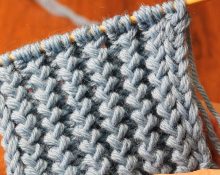Cardigans are trending today. Moreover, they can be worn at any time of the year by choosing the right yarn to create your masterpiece. There are a great many models and methods of knitting cardigans. But such products look especially impressive when a three-dimensional pattern is used to create them. One of the simplest three-dimensional patterns is the English (or patent) elastic band. It is cardigans with this pattern that we will talk about today.
How to knit a cardigan using English rib
The main secret of this voluminous and incredibly elastic pattern is the presence of yarn overs. Essentially all patent patterns are based on this element. Due to the additional length of the thread, the fabric can stretch greatly and retain an incredible volume in a calm state, so such products are especially valuable in cold winter or rainy autumn, knitted from fluffy warm yarn. But, of course, the choice is always yours: you can also knit a cozy thing from cotton thread that you’ll want to throw over your shoulders in the evening.
IMPORTANT! Despite all the unconditional beauty of the English elastic band, it has its main drawback - the high consumption of yarn. It takes almost twice as much as for a regular elastic band. However, this is the main problem of any relatively complex pattern.
Popular styles
Today, it’s easy to choose a cardigan knitted with a patent elastic band that suits you. Search queries on the Internet are full of photos with different models. For myself, I have identified the following classification of such products:
- Cropped cardigans are very fashionable and stylish. Such models are often found in branded stores of many brands. They are able to correct the figure in an interesting way and are suitable for both young people and older ladies.
- Elongated ones are generally typical cardigans, they are incredibly warm, and can be of different lengths: from mid-thigh to mid-calf. They can be worn by both slender girls and curvy women - they will look interesting on everyone.
- Regular length - reaches mid-thigh. Better suited for slender ladies, as it can focus on the problem area.
- Oversized cardigans are still in fashion and are good for any body type, but are better suited for those who are slimmer.
- With raglan sleeves - they are very convenient to knit from top to bottom on circular knitting needles in turning rows.
- With a “Japanese shoulder” - the shoulder line is lowered, the shoulder seam is shifted to the back. Perfectly corrects the figure of overweight ladies.
- Models with regular set-in and straight sleeves.
How to knit: instructions, diagrams
Today I would like to give a description of a rather interesting and, in general, simple to implement model. I will indicate the number of loops for sizes 42–46. But since the pattern itself assumes a good stretch margin, it may fit a larger size.
The yarn for this model was merino/alpaca/polyamide in a ratio of 63/27/10. In general, any thread with a similar composition and a length of about 230 g per 100 m should be suitable. In this case, circular knitting needles are used (well, because very wide ones turn out to be tight at a certain moment) with a diameter of 6 mm with a knitting density of 13 sts * 29 r. for a square 10*10 cm.
The peculiarity of the model is that the back and sleeves are knitted as one piece, and everything is knitted crosswise. Work is carried out from the left to the right sleeve (cuff). The main pattern - patent (aka English) elastic - is knitted according to the pattern:
- 1st row of knit and purl stitches;
- 2nd row - knit, straight yarn over, remove next stitch;
- 3rd row - yarn over before the purl stitch, remove stitch, the next knit stitch with the yarn over obtained from the previous row is knitted together.
You can greatly simplify your life and reduce yarn consumption by using a semi-patent elastic band (there is one in the diagram, it will come out as if turned inside out). Moreover, they will not differ in appearance - only the latter will be slightly inferior in extensibility.

Left sleeve
Cast on 37 (for size 42) or 39 (for size 46) loops and knit according to the pattern in turning rows. To expand the sleeves we make increases:
- 8 times on every 12th row, 2 loops (at the beginning and at the end of the row);
- 1 time also 2 loops in the next 10th r.
We get 57–59 loops. Having knitted 45 cm from the left cuff, we cast on the loops for the back.
Back
We cast on (as if adding from below) 66 loops with the beginning of the next front row - we get 123–125 loops. We continue knitting according to the pattern until we reach 66–70 cm in height from the beginning of knitting. We close the same 66 loops when we begin to knit the next front row.
Right sleeve
In the reverse order from how the left one was knitted, we knit the second sleeve. Instead of increases, there are corresponding decreases. We close the loops by switching to a 1*1 elastic band, according to the drawing.
Left and right shelf
Cast on 67 loops, knit 27–29 cm from the cast-on edge, then bind off the loops. To do this, we switch to a 1*1 elastic band, and knit the right front in the same way.
Assembly
We sew the sleeves, the set edges of the shelves are sewn to the side seams on the back, and the upper parts of the shelves are sewn to the front, as if raglan lines.
An unusual and stylish cardigan is ready!







 0
0





